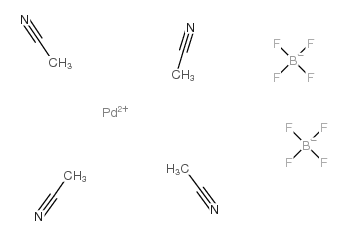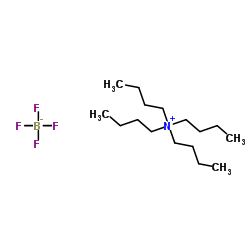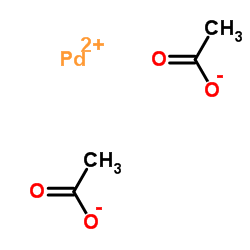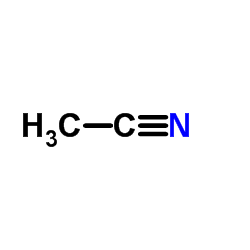TETRAKIS(ACETONITRILE)PALLADIUM(II) TETRAFLUOROBORATE

TETRAKIS(ACETONITRILE)PALLADIUM(II) TETRAFLUOROBORATE structure
|
Common Name | TETRAKIS(ACETONITRILE)PALLADIUM(II) TETRAFLUOROBORATE | ||
|---|---|---|---|---|
| CAS Number | 21797-13-7 | Molecular Weight | 444.23700 | |
| Density | N/A | Boiling Point | N/A | |
| Molecular Formula | C8H12B2F8N4Pd | Melting Point | 230ºC | |
| MSDS | Chinese USA | Flash Point | N/A | |
| Symbol |

GHS07 |
Signal Word | Warning | |
| Name | acetonitrile,palladium(2+),ditetrafluoroborate |
|---|---|
| Synonym | More Synonyms |
| Melting Point | 230ºC |
|---|---|
| Molecular Formula | C8H12B2F8N4Pd |
| Molecular Weight | 444.23700 |
| Exact Mass | 444.01600 |
| PSA | 95.16000 |
| LogP | 4.71952 |
| Appearance of Characters | Powder | Yellow |
| Storage condition | 2-8°C |
| Water Solubility | Soluble in water |
Synonym: Section 2 - COMPOSITION, INFORMATION ON INGREDIENTS
Risk Phrases: 20/21/22 Section 3 - HAZARDS IDENTIFICATION EMERGENCY OVERVIEW
Harmful by inhalation, in contact with skin and if swallowed.Air sensitive. Potential Health Effects Eye: May cause eye irritation. Skin: May cause skin irritation. Harmful if absorbed through the skin. Ingestion: Harmful if swallowed. May cause irritation of the digestive tract. Inhalation: Harmful if inhaled. May cause respiratory tract irritation. Chronic: Not available. Section 4 - FIRST AID MEASURES Eyes: Flush eyes with plenty of water for at least 15 minutes, occasionally lifting the upper and lower eyelids. Get medical aid. Skin: Get medical aid. Flush skin with plenty of water for at least 15 minutes while removing contaminated clothing and shoes. Ingestion: Get medical aid. Wash mouth out with water. Inhalation: Remove from exposure and move to fresh air immediately. If not breathing, give artificial respiration. If breathing is difficult, give oxygen. Get medical aid. Notes to Physician: Section 5 - FIRE FIGHTING MEASURES General Information: As in any fire, wear a self-contained breathing apparatus in pressure-demand, MSHA/NIOSH (approved or equivalent), and full protective gear. Extinguishing Media: Use water spray, dry chemical, carbon dioxide, or chemical foam. Section 6 - ACCIDENTAL RELEASE MEASURES General Information: Use proper personal protective equipment as indicated in Section 8. Spills/Leaks: Vacuum or sweep up material and place into a suitable disposal container. Section 7 - HANDLING and STORAGE Handling: Avoid breathing dust, vapor, mist, or gas. Avoid contact with skin and eyes. Storage: Store in a cool, dry place. Store in a tightly closed container. Store under nitrogen. Section 8 - EXPOSURE CONTROLS, PERSONAL PROTECTION Engineering Controls: Use adequate ventilation to keep airborne concentrations low. Exposure Limits CAS# 21797-13-7: Personal Protective Equipment Eyes: Not available. Skin: Wear appropriate protective gloves to prevent skin exposure. Clothing: Wear appropriate protective clothing to prevent skin exposure. Respirators: Follow the OSHA respirator regulations found in 29 CFR 1910.134 or European Standard EN 149. Use a NIOSH/MSHA or European Standard EN 149 approved respirator if exposure limits are exceeded or if irritation or other symptoms are experienced. Section 9 - PHYSICAL AND CHEMICAL PROPERTIES Physical State: Powder Color: yellow Odor: Not available. pH: Not available. Vapor Pressure: Not available. Viscosity: Not available. Boiling Point: Not available. Freezing/Melting Point: 230 deg C (dec.) Autoignition Temperature: Not available. Flash Point: Not available. Explosion Limits, lower: Not available. Explosion Limits, upper: Not available. Decomposition Temperature: Solubility in water: Soluble. Specific Gravity/Density: Molecular Formula: C8H12B2F8N4Pd Molecular Weight: 444.22 Section 10 - STABILITY AND REACTIVITY Chemical Stability: Not available. Conditions to Avoid: Incompatible materials, exposure to air. Incompatibilities with Other Materials: Oxidizing agents. Hazardous Decomposition Products: Nitrogen oxides, carbon monoxide, carbon dioxide, hydrogen fluoride gas, boron oxides. Hazardous Polymerization: Has not been reported Section 11 - TOXICOLOGICAL INFORMATION RTECS#: CAS# 21797-13-7 unlisted. LD50/LC50: Not available. Carcinogenicity: Tetrakis(acetonitrile)palladium(II) tetrafluoroborate - Not listed by ACGIH, IARC, or NTP. Section 12 - ECOLOGICAL INFORMATION Section 13 - DISPOSAL CONSIDERATIONS Dispose of in a manner consistent with federal, state, and local regulations. Section 14 - TRANSPORT INFORMATION IATA Not regulated as a hazardous material. IMO Not regulated as a hazardous material. RID/ADR No information available. Section 15 - REGULATORY INFORMATION European/International Regulations European Labeling in Accordance with EC Directives Hazard Symbols: XN Risk Phrases: R 20/21/22 Harmful by inhalation, in contact with skin and if swallowed. Safety Phrases: S 36/37 Wear suitable protective clothing and gloves. WGK (Water Danger/Protection) CAS# 21797-13-7: 2 Canada None of the chemicals in this product are listed on the DSL/NDSL list. CAS# 21797-13-7 is not listed on Canada's Ingredient Disclosure List. US FEDERAL TSCA CAS# 21797-13-7 is not listed on the TSCA inventory. It is for research and development use only. SECTION 16 - ADDITIONAL INFORMATION N/A |
| Symbol |

GHS07 |
|---|---|
| Signal Word | Warning |
| Hazard Statements | H332 |
| Personal Protective Equipment | dust mask type N95 (US);Eyeshields;Gloves |
| Hazard Codes | Xn:Harmful; |
| Risk Phrases | R20 |
| Safety Phrases | S22-S38-S36/37/39 |
| RIDADR | UN2811 |
| WGK Germany | 3 |
| Packaging Group | III |
| HS Code | 29310099 |
|
~57% 
TETRAKIS(ACETON... CAS#:21797-13-7 |
| Literature: Journal of the American Chemical Society, , vol. 129, # 8 p. 2246 - 2247 |
| Precursor 3 | |
|---|---|
| DownStream 0 | |
|
Extended-chain, multinuclear transition metal complexes bridged by cyanodiazenido(1-), [N=N-C[triple bond, length as m-dash]N]-, ligands.
Dalton Trans. (32) , 3538-45, (2007) Extended-chain complexes containing multiple transition metal centres linked by conjugated micro-cyanodiazenido(1-) ligands [N=N-C[triple bond, length as m-dash]N]- have been obtained by reaction of t... |
|
|
Unique 2:1 complex with a trans-chelating bis-pyridine ligand.
Inorg. Chem. 41(8) , 2296-300, (2002)
|
|
|
Gorman, C. B.; Vest, R. W. et al.
Macromolecules 32 , 4157, (1999)
|
| [Pd(NCMe)4][BF4]2 |
| [(MeCN)4Pd][BF4]2 |
| ditetrafluoroborate |
| [Pd(MeCN)4](tetrafluoroborate)2 |
| MFCD00043297 |
| [Pd(CH3CN)4][BF4]2 |
| [Pd(acetonitrile)4](BF4)2 |
| [Pd(MeCN)4](BF4)2 |
| Palladium(II) tetrafluoroborate tetraacetonitrile complex |




